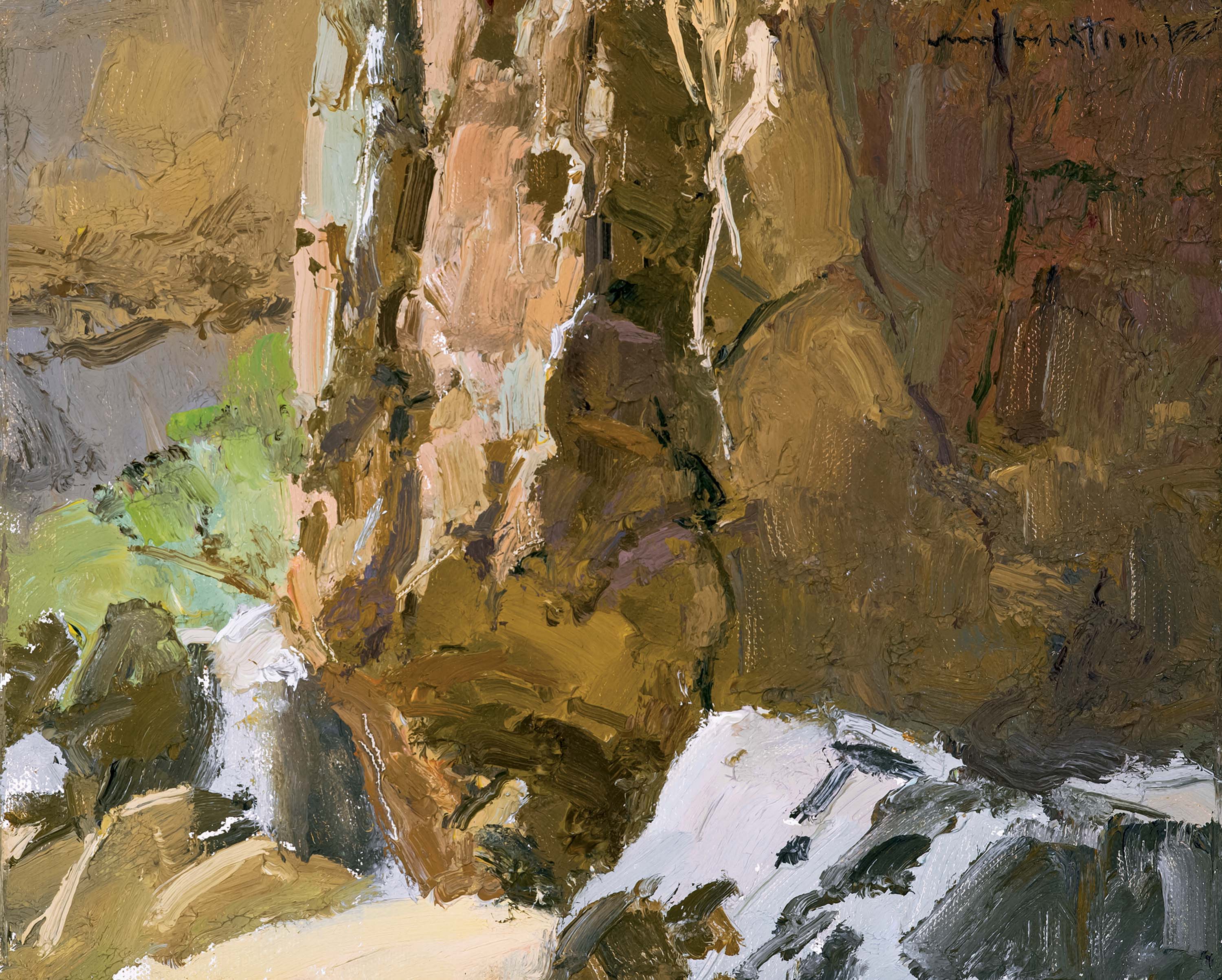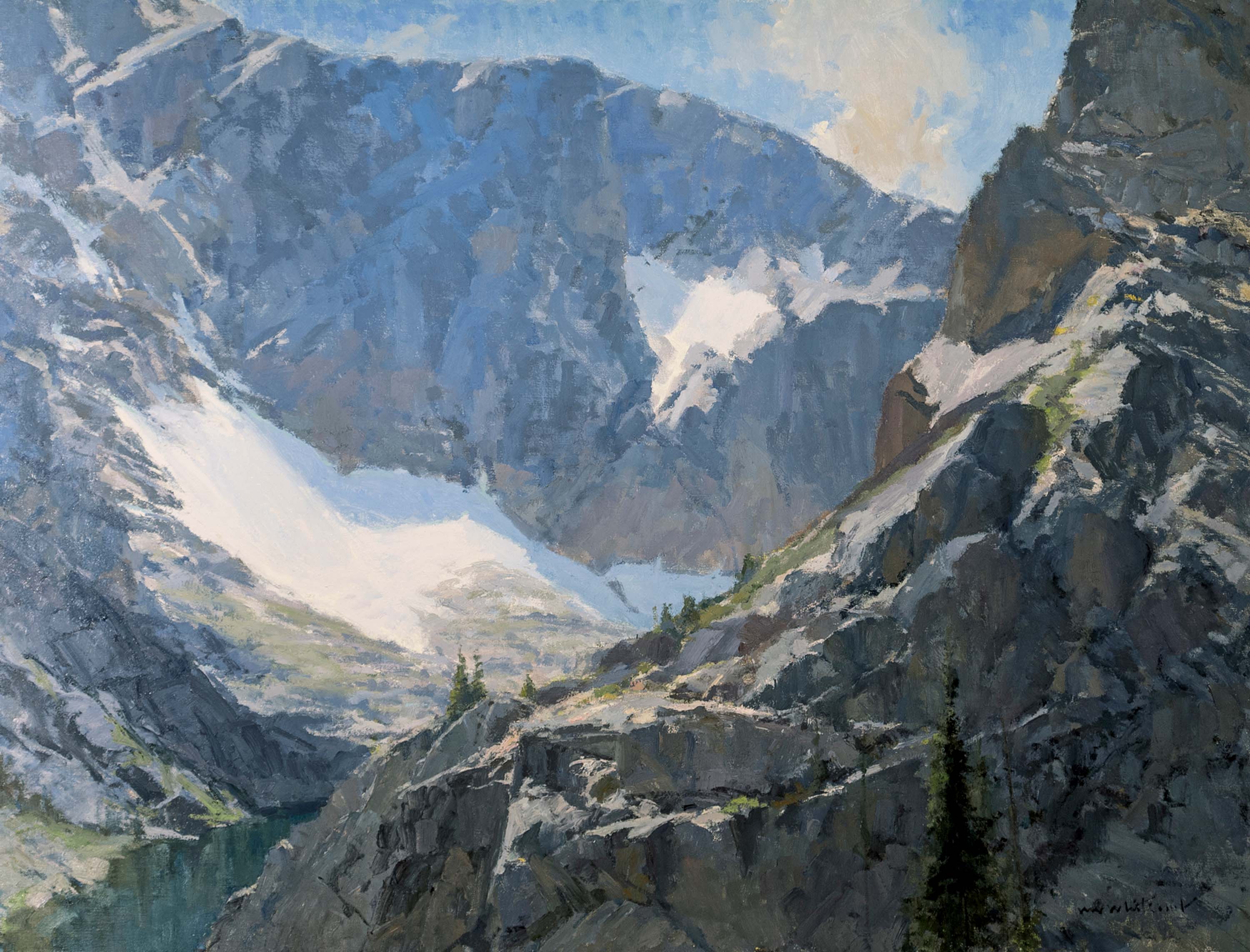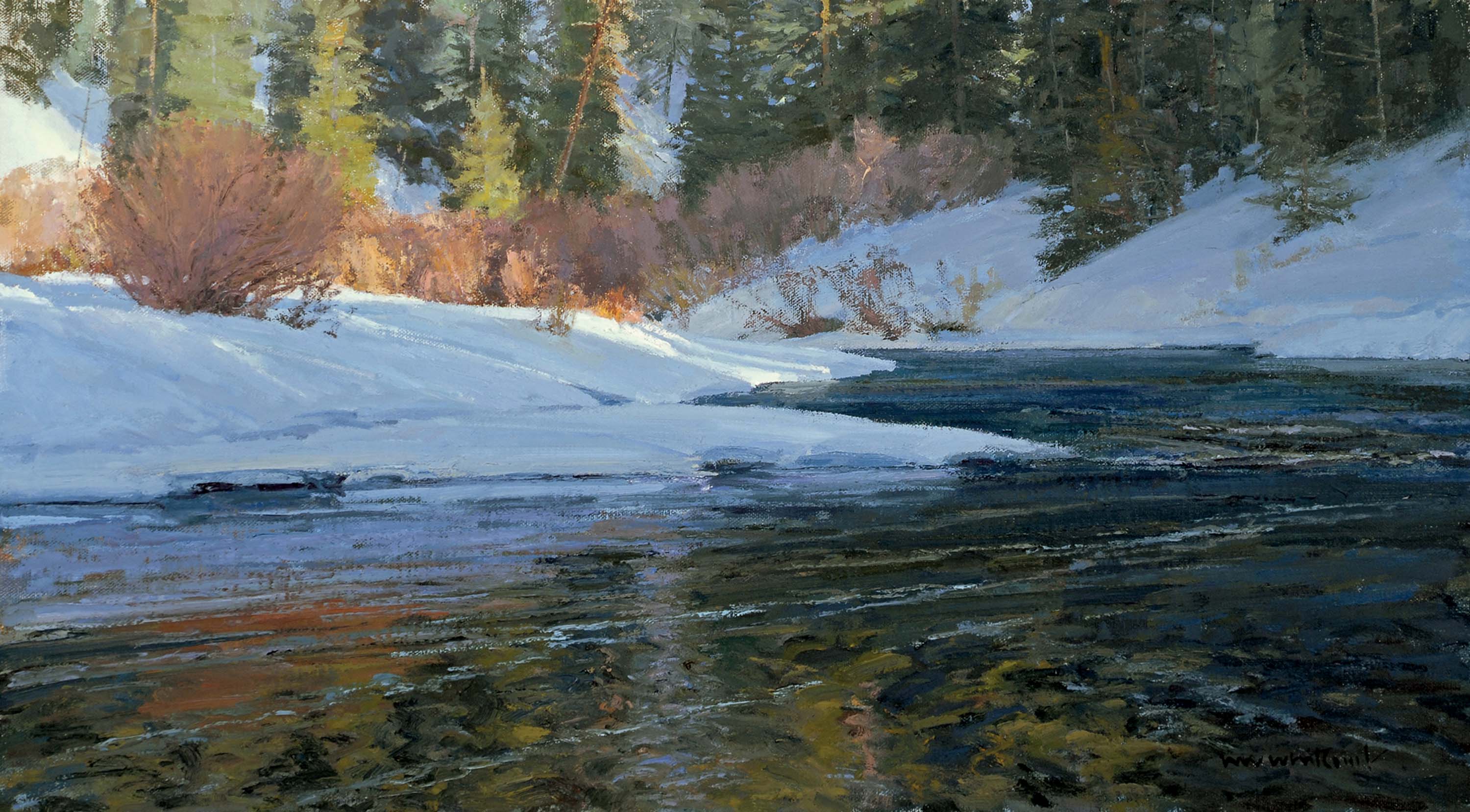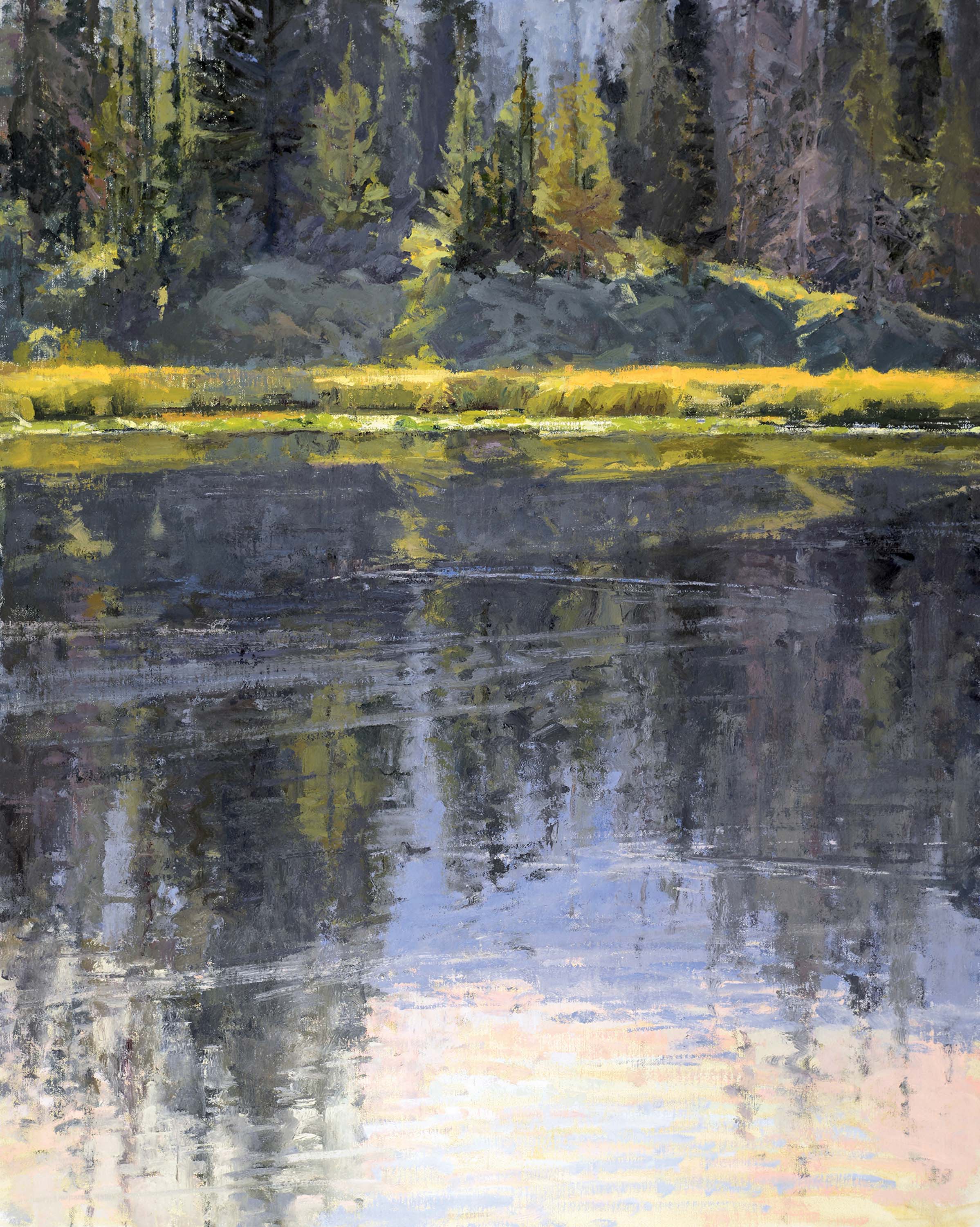
30 May Eyeing Beauty
ARTISTS BY NATURE CAN BE TEMPERAMENTAL, tormented souls. Some are fraught with gigantic egos and breathtaking insecurities. Some crave attention and suffer manic bouts of highs and lows in their exploration of light and shadow. Some pander to the market and hire PR people to “brand” them, yet lose them grounding essence of who they really are.
Not Milo “Skip” Whitcomb.
It’s true that Whitcomb has run with an incredibly gifted pack of American painters, earning his own place among them. But no one has ever accused him of being a self-absorbed alpha in need of hero worship.
Across four decades, Whitcomb and his colleagues — all possessing affinity in some way for the Rockies — have left their marks on a genre of landscape painting known as contemporary Western Regionalism.
Theirs has been a bold declaration that the modern West does not need to be over-romanticized in order to be appreciated, nor should Western art be narrowly defined by mythological portrayals of cowboys and Indians in order to have an identity.
“The West is so much more than a cliché,” Whitcomb says. “And I think that art should reflect it.” The roster of influential names who hold this as true speaks for itself and includes George Carlson, Russell Chatham, Clyde Aspevig, Len Chmiel, T. Allen Lawson, Matt Smith, Bob Barlow, Kathy Wipfler, Ralph Oberg, Tucker Smith, Jim Morgan, Dan Young, Scott Christensen, Geoff Parker, Ned Jacob and the late William F. Reese, among others.
Even as acclaim has rained down on them for charting their own course, Whitcomb, ever reserved, has been content to stay clear of fawning limelight, tending instead to his art, his teaching and, more recently, to exploring larger compositions.
If there is a measure of his stature and level of respect, it is that painters, sculptors and prominent collectors proudly have Whitcomb’s field studies in oil, watercolor and pastel on their walls. The pieces — which he calls “on-the-spot” and not plein air — are daily reminders of what happens when a talented interpreter of nature responds spontaneously to his native realm.
“There are a lot of insightful artists out there, but I have always believed that Skip Whitcomb sees more than most people do,” says Susan Simpson Gallagher, a former museum curator who operates her own gallery in Cody, Wyoming. “In his work there is always a distillation of light, a simplifying of form that makes me want to really look at his paintings and spend time with them.”
This September, Whitcomb is headlining a three-artist show at Simpson Gallagher Gallery, along with Len Chmiel and Matt Smith. With at least 10 works on display, it represents the largest viewing of new Whitcombs in 25 years.
Considering that interludes with Whitcomb and his art are rare, Simpson Gallagher wants to share the experience with others, too. That’s why she timed the celebration of Whitcomb, Chmiel and Smith to coincide with the annual Buffalo Bill Art Show & Sale, when collectors from around the world descend upon her quiet Old West town.
It’s been a profound period of revelation and reflection for Whitcomb. “The older I get, the more humbling that the experience of painting is — and I don’t say it lightly,” he explains. “This thing that we call life is so huge and unruly. You think the important stuff is external, but after my scare, I began looking deeper into the personal depths that needed to be plumbed. You can’t get cheeky when you talk about this mortality stuff; you can’t, with arrogance or aloofness, take your work for granted or get complacent, because it can put you on the ground posthaste. I know.”
Born in 1946, Milo W. Whitcomb Jr. has long answered to the nickname “Skip,” and while it is endearing, it detracts from the serious intensity and grace he brings to his art.
Even now, merging upon his seventh decade, Whitcomb maintains an unassuming personality that results from his growing up a ranch kid outside of Sterling, Colorado, where his grandparents and parents raised quarter horses.
Like so many other rural Front Rangers, Whitcomb could have easily turned into a gentleman cowboy for the rest of his life. Instead, he went off to the Art Center College of Design in Los Angeles, attending classes there at the same time Chmiel did. Realism was most certainly not en vogue. Whitcomb, nonetheless, sought out classical instruction and became adept with handling any media, even etching. He came home to Colorado and fell under the tutelage of Ned Jacob who had a studio down the street from Whitcomb in downtown Denver.
“Ned was the tip of the spear for so many of us. He was the one who really introduced so many of us to the power of working outdoors, of working directly from nature and what it meant to be a true landscape painter, not like the guys back East at that time who mostly sat in their studios,” Whitcomb says. “He introduced that whole sense of ethics to the profession, the camaraderie, the generosity of sharing insight; that is a Western phenomenon. He’s the guy that blazed a trail for two generations.”
Foremost, Jacob emphasized that “the totality of any concept starts with the drawing and its design,” Whitcomb says. “I started out as a figure painter and, at Ned’s encouragement, turned to landscapes. He told me, ‘I will help but you have to do what I tell you,’ and the first thing he was send me outside. He had faith. He believed.”
Ken Bunn, the renowned wildlife sculptor and member of that early Denver scene, says Whitcomb isn’t part of any plein air movement. “Skip and the bunch of guys he hangs out with were plein air painters before anyone out here even knew what plein air was,” Bunn explains. “I think his best compositions are those that began as on-the-spot responses. I’ve always respected artists who consciously avoid painting the obvious, so naturally I’ve liked what he does.” Whitcomb’s prowess with on-the-spot painting outdoors — thumbnails or quickly rendered sketches — is legendary. He prefers using those instead of photographic reference, and in addition to helping him key in color for larger studio paintings, they possess a kind of spontaneous energy.
Plein air isn’t an end to itself, merely a starting point, Whitcomb says, stacks of field studies neatly organized around him. “The outdoor work is an endless resource for the studio. I constantly go through them. Even something I did 20 years ago can all of a sudden spark an idea, a concept that I want to take further. Often, you may not realize what you are relating in a moment and it may take you years before you comprehend.”
“When I walk into Skip’s studio I am always amazed at the art materials on tables, on chairs, on bookcases,” Simpson Gallagher says. “I am mystified how he can make decisions about which of the hundreds of pastels or paint tubes to use. I am in awe that he knows and uses all of his materials and how he uses them to his advantage.”
Whitcomb, she adds, is grounded in fundamentals. “We see his finished work. But what we don’t see often enough are the multiple preparatory drawings and his extensive work in the field that lead up to it. He is always exploring, playing with texture and temperature, with various mediums and points of perspective. He manipulates design and abstraction to a degree that it is almost unprecedented in representational art.”
For years, Rose Fredrick has been exhibition curator for the annual Coors Western Art Show in Denver. Whitcomb’s work, she says, exudes a vision that cannot come from an interloper, no matter how talented. “Skip is as Western as they come; he just isn’t painting stereotypical ‘Western art,’” Fredrick says. “He paints the land he’s known from birth, land he’s hiked, fields he worked in his youth, paths he continues to bike across. He paints like an insider — if there are ‘insiders’ to the Western genre as there are ‘insiders’ in the L.A. or New York art scenes — and through his art we all learn to revere the West and appreciate what we have here. Skip’s work rings true.”
Fredrick describes Whitcomb as a naturalist who is both a master draftsman and colorist. “I’ve never thought of Skip as a plein air painter, maybe because he’s always painted both on location and in his studio, and somehow the work that results from either venture has the same exquisite sense of the earth and sky and everything in between,” she says.
In person, Whitcomb is unpretentious, and when making chitchat can come off as plainspoken. He is also deceivingly well read, widely conversant and learned on subjects ranging from art history to literature of the West.
On excursions with his pals, Whitcomb has painted all around the United States, the Caribbean and Central America. Absence from the West really has made his ardor for the region grow fonder. When he’s in the studio near Fort Collins, getting outside — hiking in the foothills or walking the banks of the Cache La Poudre River — fills him with the solutions he needs to prevail over challenges that come with pieces on the easel. He often has four or five major works going at a time and their completion can take months.
“You can become deaf to the conversation you should be having with a painting to the point you’re not hearing it,” he says. “The dialogue is one of the most important elements in giving these things life. The painting starts to speak to you, it tells you what it needs. You lay the groundwork and it becomes its own entity. When I fail, it’s because I am not listening.”
When we dive deeper into his philosophical impulses as an artist, he doesn’t pull out a pithy quote from a deceased master, but turns to Shakespeare and the Fool in King Lear, who asked, “Who is it that can tell me who I am?”
Whitcomb isn’t jesting, for he has confronted his maker, twice, each time shaking him until he became more awake. Thirty years ago, he had gone in for knee surgery to repair a joint that had worn out from skiing and hiking — “a byproduct of my misspent youth,” he says. During recuperation at home, something felt wrong. Shots of severe pain radiated from the back of his leg. While in the hospital having tests, he suffered a pulmonary embolism caused by a blood clot that passed through his heart and became lodged in a lung.
“My wife, Maggie, and son, Trace, were there at my bedside. I couldn’t breathe and everything was starting to go dim. I didn’t have a chance to tell them I loved them.”
And then his vision sunk into darkness. Whitcomb went into cardiac arrest and had to be resuscitated with a defibrillator. For several moments, there was no certainty he would return. “The doctor told me I had gone as far as anyone could to never coming back,” he says, his voice fading into a long pause.
In those minutes when Whitcomb was technically dead, he did not catch a glimpse into the great beyond, he says, but he had the epiphany of knowing how much he had squandered by not paying attention to what was important. “The appreciation I had for the spirit of beauty became indescribable,” he says.
Decades passed. Respect for his body of work grew and then, six years ago, he suffered a stroke. Again, the artist somehow survived. “It was particularly frightening because it took out a couple of information files in my brain’s hard drive and required that I go back and relearn some of the things about painting I had always known,” he says. “In the big picture, it was a gift because there were directions I wasn’t exploring because I had put them off.”
Those directions — experimenting with more abstraction — are at the center of what he does and it has met with an enthusiastic reception. “I have more than I’ve ever had in my life. What I’m trying to do with this third chance I’ve been given, and the ensuing years, is define my connection and place in the West.”
Harmonizing color, value, light, patterns, shapes and design, which were always his hallmarks, have become more vivid. He says he is trying to communicate the fluid forces of time. It might be the jumble of converging ancient geology, as in Volcanic Artifacts, a field study now being turned into a major work for the Simpson Gallagher show. Or the path that glaciers carved through the mountains in Glimpse of Lake Gadsby. Or the eternal luminescence of flowing water in Into the Light and Coot Contrails – Lily Lake. Or the quaint, welcoming sight of a farmhouse located along a country lane and backdropped by a summer sky fuming with thunderheads.
Whitcomb has collector friends in every corner of the West. One especially cherished family is the Swift clan, who owns a ranch outside of Pinedale, Wyoming. The property, located in the Upper Green River Basin, is a gathering point for family members living in the region and others who make annual pilgrimages out from Chicago, their home base. Sara Swift says she and her husband received their first two Whitcombs as wedding presents, and now they own eight, many that have come as a result of the artist staying at the ranch and observing how the family interacts with the property to better understand how they see it.
“Skip’s work always reminds us of a place we want to be. Living in Chicago and looking at his picture above our bed every night — a scene of sagebrush and yellow wildflowers and the Wind River Mountains — helps us dream about the land that holds our heart,” she says.
That sentiment applies to folks in Pinedale, too. As a gift to the community, the Swifts commissioned a major landscape painting that hangs in the commons area of the Pinedale Public Library.
Whitcomb rejects easy labels and asserts that the so-called 21st-century plein air craze is overblown. There is nothing inherently superior about painting outside if the person doing it is not allowing the elemental forces of nature, the rhythms and pulses of the seasons, the dust and the sunburn to seep into their souls, he says.
“The painting world is becoming more homogenized through publications, workshops and the cross – pollination of a plethora of these destructive industrial strength ‘plein air’ events,” he says. “It’s a complex phenomenon, but I sincerely believe there is a distinctive spirit surrounding Western Regionalism which sets it apart from work being done in other parts of the country. Today’s painters in the West, the great ones anyway, are more interpretive of the landscape and environment in ways that range from abstract impressions to broadly composed naturalistic essays. Each one of us is seeking a personal connection.”
A few decades ago, Texan Suzanne Pierce, then making her own start as a painter, ran across a Whitcomb in an art magazine and was immediately struck by how his work seemed to vibrate with color. She and her husband acquired their first Whitcomb not long afterward, and today they have several pieces of various sizes and mediums in their collection. Another detail worth noting is that Pierce has attended different art workshops on outdoor painting that Whitcomb has taught.
“We love the way Skip handles the West and what he does is distinctive,” she says, while admiring a Whitcomb portrayal of a mountain stream done in pastel that is displayed prominently in her home. “I could stand here for hours and move between the little beautiful nuances of his work, and you wonder how did he achieve that effect? He brings me in with the big shapes and values and colors, but every time you look closer you discover something new.”
While interacting with Whitcomb as her teacher, Pierce says she appreciates the steady calmness he brings to the creative process, packing no personal airs. “He’s one of the most giving teachers I’ve ever met. Nothing gives him more pleasure than seeing his students stumble upon insights. As a painter, he doesn’t get distracted by the other stuff, like chasing fame. He just likes to paint. It is his passion.”
“The most obvious way to paint nature, as Ned Jacob harped long ago, is standing in the middle of it,” Whitcomb says. “If I keep an open mind, I see all these wonderful relationships and juxtapositions I could never invent in my studio. I try to look at the landscape as if I’m seeing it for the very first time. You have to paint from inside yourself; otherwise you are simply recording like a camera. There really is a higher reality.”
Following another sojourn to the Cache La Poudre, on the day we spoke Whitcomb was savoring a flood of the senses he experienced and was trying to translate it into a painting for the 2015 Prix de West. “It usually begins for me with the scent of the cottonwoods and it elicits inside me a memory that has been with me forever,” he says. “It fires everything else up, the same as breathing in whiffs of wet sagebrush after a rain or the aroma of spruce in the mountains or the prehistoric pungent sniff of sulfur brimming out of the geothermal vents in Yellowstone. To me, these are things that stoke reality.”
Everything Whitcomb paints is part of a search to find meaning.
“A great painting is never about just the subject. The secret an artist is trying to convey to the viewer is what the subject represents on a number of planes.”
For him, in the end, a painting is about the painting, not as a subject or object, but for the emotions it stirs within us as we all pass on our own individual journeys of discovery. “All that we have for sure is this moment together, so let’s savor it,” he says.
Quiet again, his voice cracking, Whitcomb thinks about the future. “Making an honest picture demands that all of us in the creative arts — no matter whether we’re painters, sculptors, photographers or writing literature — maintain a keen and discriminating eye. It means keeping the faith of who we are in pursuit of what we know to be our truths. Above all, stay humble.”
- “Volcanic Artifacts” | Oil on Linen | 8 x 10 inches
- “Glimpse of Lake Gadsby” | Oil on Linen | 32 x 42 inches
- “Into the Light” | Oil on Linen | 20 x 36 inches
- “Fishing Canoes on Beach” | Watercolor on Paper | 11 x 14 inches
- “Coot Contrails – Lily Lake” | Oil on Linen | 40 x 32 inches











No Comments